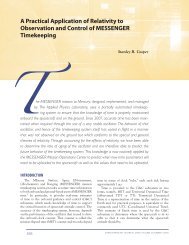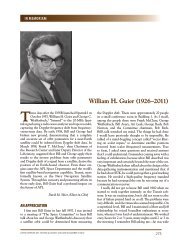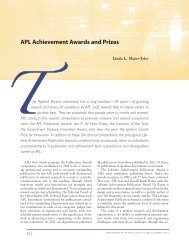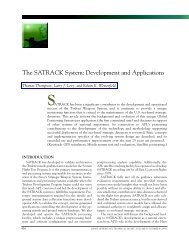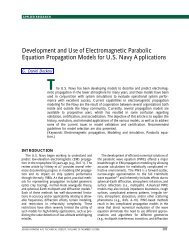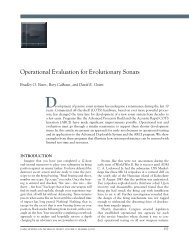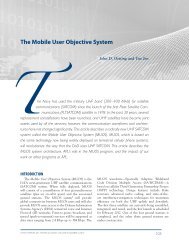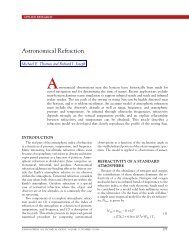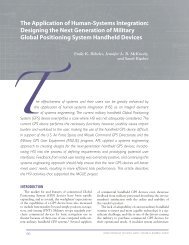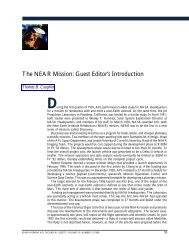Aircraft Wake Detection Using Bistatic Radar: Analysis of ...
Aircraft Wake Detection Using Bistatic Radar: Analysis of ...
Aircraft Wake Detection Using Bistatic Radar: Analysis of ...
Create successful ePaper yourself
Turn your PDF publications into a flip-book with our unique Google optimized e-Paper software.
R. J. IANNUZZELLI ET AL.<br />
mean speed <strong>of</strong> advance U are neglected, thereby allowing<br />
the equations to be reformulated and solved as a<br />
marching problem in x. The need to store model<br />
variables at locations along the x axis is eliminated,<br />
thus reducing the problem from three to effectively<br />
two spatial dimensions.<br />
To initialize AWEC model calculations, estimates <strong>of</strong><br />
data are needed at a vertical (y–z) plane close to the<br />
origin. For submarine wake predictions, a separate<br />
program, FWI, 13 is used to generate estimates <strong>of</strong> component<br />
wakes for the many sources that contribute to<br />
the composite wake signature. FWI stores relevant<br />
geometrical variables for different submarines and uses<br />
these values along with operating conditions provided<br />
by the user to compute estimates for variables such as<br />
the size and strength (circulation) <strong>of</strong> vortices shed by<br />
the hull and control surface. For the present aircraft<br />
vortex calculations, it was a fairly straightforward<br />
exercise to add a file containing the wingspan and<br />
other relevant geometrical variables for a C-130 transport<br />
and to use existing s<strong>of</strong>tware to calculate the required<br />
initial plane data. Since the inviscid theory<br />
applied to derive the vortex circulation equations in<br />
FWI was originally developed for the aircraft vortex<br />
problem, there was little risk in applying those same<br />
equations to the problem at hand. And since, unlike<br />
submarine wakes, aircraft wakes are dominated by a<br />
single component, all sources other than wing vortices<br />
could safely be ignored.<br />
Run 9<br />
During run 9, the aircraft was assumed to be in level<br />
flight at an altitude <strong>of</strong> 83.8 m, with an air speed U <strong>of</strong><br />
64.3 m/s. The plane’s weight was taken to be 143,000<br />
lb (64,865 kg), and the lift force L was assumed equal<br />
and opposite to the weight. The wingspan B was about<br />
40.4 m.<br />
The initial vortex circulation 0 was estimated<br />
from the inviscid theory. Assuming elliptical loading,<br />
0<br />
= L<br />
Ub<br />
0<br />
2<br />
= 312 ms / , (13)<br />
where the density <strong>of</strong> air = 1 kg/m 3 , and the vortex<br />
core separation b 0 is given by<br />
<br />
b 0=<br />
B= 31. 7 m. (14)<br />
4<br />
The diameter <strong>of</strong> the vortex core D V is given theoretically<br />
by<br />
D V = 0. 197b0 ,<br />
(15)<br />
which yields an estimate <strong>of</strong> D V = 6.25 m for the<br />
C-130. This value was considerably larger than the<br />
observed core diameter <strong>of</strong> approximately 1 m. The<br />
latter value was determined by the visible boundary <strong>of</strong><br />
the entrained smoke in the photographs. Despite this<br />
discrepancy, the larger theoretical value was used in<br />
the model calculations. Use <strong>of</strong> the smaller value would<br />
have required a minimum grid separation distance<br />
much smaller than the 0.5 m used in the present<br />
calculations, which would have resulted in a nearly<br />
prohibitive increase in the computational burden.<br />
The net downward vertical velocity w 0 induced by<br />
one vortex acting on another is given by<br />
−Γ<br />
w 0=<br />
2b<br />
310 JOHNS HOPKINS APL TECHNICAL DIGEST, VOLUME 19, NUMBER 3 (1998)<br />
0<br />
0<br />
=−157<br />
. m/s . (16)<br />
The atmosphere was assumed to be weakly stratified<br />
with a potential temperature gradient <strong>of</strong> 6.7 10 3<br />
°C/m. Values <strong>of</strong> potential temperature were converted<br />
to density for use by AWEC. Ambient levels <strong>of</strong> turbulence<br />
kinetic energy and turbulence kinetic energy<br />
dissipation rate were chosen to be 0.1 m 2 /s 2 and 2 <br />
10 3 W/kg, respectively.<br />
Figure 13 depicts vector velocities at times late t <strong>of</strong><br />
1.4 (the initial plane), 9.0, 21.0, and 31.0 s. Since the<br />
wing was positioned near the top <strong>of</strong> the fuselage (effective<br />
diameter <strong>of</strong> approximately 5.2 m) on the<br />
C-130, the vortex cores initially were situated 86.4 m<br />
AGL. Figure 14 shows contours <strong>of</strong> the turbulence<br />
kinetic energy for two <strong>of</strong> these times late, 1.4 and 31.0.<br />
The position <strong>of</strong> the radar common volume, which is<br />
centered at 45.7 m AGL, is also shown.<br />
Figure 15a plots the position <strong>of</strong> the vortex cores<br />
(solid curve) as a function <strong>of</strong> t. The heavy dashed line<br />
indicates where the vortex positions would be if the<br />
wake descended at a constant velocity given by the<br />
induced velocity computed from Eq. 16. The actual<br />
vortex descent begins near this speed but then slows.<br />
The fixed upper and lower boundaries <strong>of</strong> the common<br />
volume are indicated by a pair <strong>of</strong> solid horizontal lines.<br />
The outlying lighter dotted lines indicate the first<br />
contour level above ambient <strong>of</strong> the turbulence kinetic<br />
energy distribution.<br />
From Fig. 15a it is estimated that the leading edge<br />
<strong>of</strong> the vortex wake first reached the common volume<br />
approximately 12 s after aircraft passage and that the<br />
vortex cores were within the common volume between<br />
t ≈ 29 and 33 s after aircraft passage. <strong>Radar</strong> results discussed<br />
previously show a distinct signature at t = 31 s,<br />
which appears consistent with the model prediction.<br />
This result, however, could be fortuitous as it depends<br />
on the aircraft altitude at the time <strong>of</strong> passage, and there<br />
is considerable uncertainty in the estimates <strong>of</strong> altitude<br />
obtained from the C-130 pilot.




